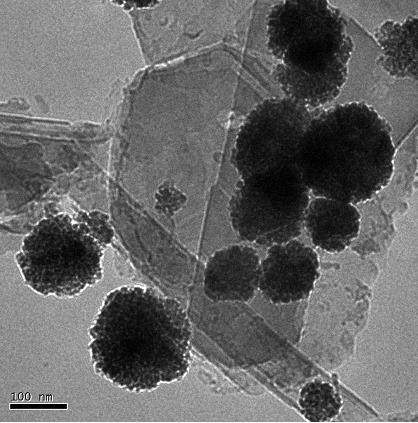Immobilized enzyme for magnetic nanometer clay carrier and regenerating method thereof
A magnetic nanometer, immobilized enzyme technology, applied in the direction of immobilization on or in inorganic carriers, biochemical equipment and methods, enzymes, etc., can solve the problems of carrier non-regeneration, limited application, limited application of magnetic nanoclay materials, etc. Achieve the effect of simple and easy regeneration method, easy recovery and recycling
- Summary
- Abstract
- Description
- Claims
- Application Information
AI Technical Summary
Problems solved by technology
Method used
Image
Examples
Embodiment 1
[0031] Example 1 The magnetic nano-clay carrier immobilized the enzyme, including the immobilized object being the glucoamylase and the corresponding immobilized enzyme carrier, and was made by the covalent coupling method as the immobilization method. The carrier is magnetic nano Fe 3 o 4 clay composites, the magnetic nano-Fe 3 o 4 Clay composites composed of magnetic Fe 3 o 4 Nanoparticles and nanoclay materials, and the magnetic Fe 3 o 4 Nanoparticles are orderedly assembled on the nanoclay.
[0032] Among them: magnetic nano-Fe 3 o 4 Clay composites refer to the first FeCl 3 ·6H 2 O was dissolved in ethylene glycol at a weight-to-volume ratio of 1:20 (kg / L) to form a clear solution; then NaAc and polyethylene glycol were added to the clear solution, and then hydrochloric acid-activated nanoclay was added to the clear solution In the solution, ultrasonically disperse (40kHz) for 1 hour to obtain a mixed solution; finally, add the mixed solution to a polytetr...
Embodiment 2
[0035] Example 2 The magnetic nano-clay carrier immobilized the enzyme, including the immobilized object being the glucoamylase and the corresponding immobilized enzyme carrier, and was made by the covalent coupling method as the immobilization method. The carrier is magnetic nano Fe 3 o 4 clay composites, the magnetic nano-Fe 3 o 4 Clay composites composed of magnetic Fe 3 o 4 Nanoparticles and nanoclay materials, and the magnetic Fe 3 o 4 Nanoparticles are orderedly assembled on the nanoclay.
[0036] Among them: magnetic nano-Fe 3 o 4 Clay composites refer to the first FeCl 3 ·6H 2 O was dissolved in ethylene glycol at a weight-to-volume ratio (kg / L) of 1:50 to form a clear solution; then NaAc and polyethylene glycol were added to the clear solution, and then hydrochloric acid-activated nanoclay was added to the clear solution In the solution, ultrasonically disperse (40kHz) for 5 hours to obtain a mixed solution; finally, add the mixed solution to a polytet...
Embodiment 3
[0039] Example 3 The magnetic nano-clay carrier immobilized the enzyme, including the immobilized object being the glucoamylase and the corresponding immobilized enzyme carrier, and was made by the covalent coupling method as the immobilization method. The carrier is magnetic nano Fe 3 o 4 clay composites, the magnetic nano-Fe 3 o 4 Clay composites composed of magnetic Fe 3 o 4 Nanoparticles and nanoclay materials, and the magnetic Fe 3 o 4 Nanoparticles are orderedly assembled on the nanoclay.
[0040] Among them: magnetic nano-Fe 3 o 4 Clay composites refer to the first FeCl 3 ·6H 2 O was dissolved in ethylene glycol at a weight-to-volume ratio (kg / L) of 1:35 to form a clear solution; then NaAc and polyethylene glycol were added to the clear solution, and then hydrochloric acid-activated nanoclay was added to the clear solution The solution was ultrasonically dispersed (40kHz) for 3 h to obtain a mixed solution; finally, the mixed solution was added to a poly...
PUM
| Property | Measurement | Unit |
|---|---|---|
| particle size | aaaaa | aaaaa |
Abstract
Description
Claims
Application Information
 Login to View More
Login to View More - R&D
- Intellectual Property
- Life Sciences
- Materials
- Tech Scout
- Unparalleled Data Quality
- Higher Quality Content
- 60% Fewer Hallucinations
Browse by: Latest US Patents, China's latest patents, Technical Efficacy Thesaurus, Application Domain, Technology Topic, Popular Technical Reports.
© 2025 PatSnap. All rights reserved.Legal|Privacy policy|Modern Slavery Act Transparency Statement|Sitemap|About US| Contact US: help@patsnap.com

